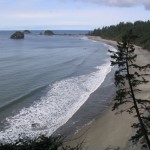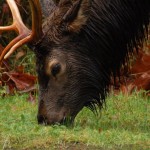The climatic zone of Olympic National Park, like all of the Pacific Northwest, is Temperate. Variations from this norm, to either extreme, are short-lived. Temperatures below 20ᵒF/-7ᵒC or above 90ᵒF/32ᵒC occur rarely and only last a day or two. The average daily temperature range runs closer to 35ᵒF/2ᵒC to 50ᵒF/10ᵒC from October until March, and 55ᵒF/13ᵒC to 70ᵒF/21ᵒC the rest of the year. These approximations are valid at sea level and can vary with the specific terrain.
A lot of climatic variation can be found in the Park’s numerous valleys, on the ridges and at various elevations. Knowing what you might encounter can help optimize your enjoyment. The valleys, with their virgin forests, retain more cold air and snow pack in the winter and more warm air in the summer. A Valley that runs north-south will shed snow faster than one that runs east-west. Ridges in the Park tend to be colder-wetter on the north faces and warmer-dryer on the south.
Generally the higher you go, the colder it is. The temperature drops about 3ᵒF/-16ᵒC for every 1000 feet/305 meters of elevation gained. Also, be aware that ultraviolet light exposure increases with elevation. Winter temperature inversions can and do reverse the norm, however, and create warmer instead of colder temperatures at elevation. Temperature, at elevation, is a critical piece of information particularly for winter climbing in the Park.
Finally, because the predominant flow of weather and moisture arrives in the Park from the southwest, the western side of the park is the wettest, receiving an average of 135+ inches per year. The northeast corner is the driest, getting only about 17 inches per year, and everything else has annual rainfall at or slightly above the 35-38 inches of precipitation per year enjoyed by most of western Washington State.
Olympic National Park has trails and superb sights that will astound you. Take the time to consider the season, terrain, and elevation before you start out. Let your memories of the experience be focused on the Park’s stunning beauty so that your recounting of them won’t begin with a list of gear you should or shouldn’t have taken with you.



